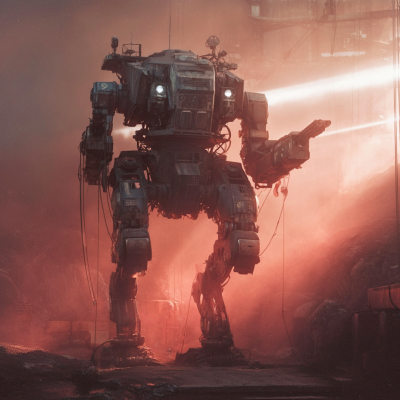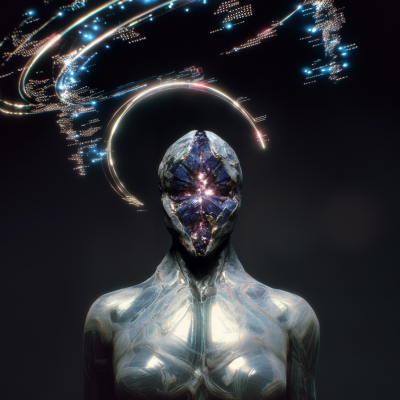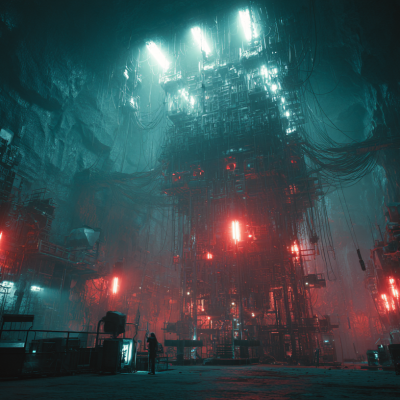August 28, 2022. Midjourney V3.
I typed something like “robots on Mars” and hit generate. What came back was… well, let me show you.

Orange-painted machines that looked more like construction equipment having an identity crisis than military hardware. Multiple robots in odd proportions, standing on a Martian landscape that I’d probably accept but mechs that I absolutely wouldn’t. There’s a peculiar quality to early AI-generated images—dreamlike, almost surreal, with details that your brain knows are wrong even if you can’t immediately articulate why.
But I could see the potential. Somewhere in that chaotic generation was the kernel of what I needed: bipedal war machines on Mars, battle-tested and brutal, ready to tell the story of Fall of the Titans.
I just had to find them.
The Three-Year Hunt
It’s November 2025 now. That means I’ve been chasing the perfect Dire Wulf for over three years. Hundreds—maybe thousands—of generated images. Countless prompt iterations. Multiple Midjourney versions. Entire aesthetic philosophies built, tested, discarded, rebuilt.
And I’m still refining it.
Let me walk you through what it takes to forge a Robot Core from digital steel.
What Is Dire Wulf TB303?
Before we dive into the visual journey, let’s establish what I’m trying to create:
Dire Wulf TB303 is a Pathfinder-class Robot Core—the lightest, fastest, most agile class in the Neo Helsinki arsenal. Where Strider-class mechs are workhorses and Phoenix-class are flying artillery platforms, Pathfinders are wolves. Covert operations specialists. Reconnaissance experts. Hit-and-run predators.
The “TB303” designation? That’s a reference to the Roland TB-303 bass synthesizer, the legendary machine that defined acid house and electronic music. As a musician, I wanted Dire Wulf to carry that connection—the rhythmic pulse of electronic warfare translated into steel and weaponry.
Key characteristics I needed to capture:
- Bipedal and humanoid – Standing on two legs like MechWarrior and Titanfall mechs, with a torso that houses a pilot
- Light and agile – Not bulky, not tank-like, but sleek and aggressive
- Wolf-inspired but not animal-like – Angular, predatory aesthetics without literally being a robot wolf
- Industrial brutalism – Functional military hardware, not decorative hero mechs
- Battle-worn – Mars dust, laser scoring, emergency field repairs
- Soul Prism powered – Cyan glow from the backpack engine where an alien consciousness provides power
- Neo Helsinki colors – Black armor with red highlights
- Weapon systems – Long-range rifle and a close-combat plasma sword
Getting all of that into a single coherent image? That’s the challenge.
The Turning Point: Finding the Language
For months, I struggled. The results were inconsistent—sometimes too animal-like, sometimes too clean and pristine, sometimes the proportions were completely wrong. I was generating variations blindly, hoping something would click.
Then, in my prompt evolution, something shifted. I wrote this:
“A massive mech emerges from a smoking crater in mars, lasers firing, its armor a mix of Titanfall 2’s futuristic aesthetics and Mechwarrior’s rugged, industrial mechanics. Hydraulic pistons hiss as it steps forward, armed with pulse cannons and missile pods. The battlefield around it is filled with wreckage and smoke, the remnants of a fierce battle. Dust and debris rise with each step, creating an epic, cinematic scene of destruction and war”

This was it.
Not perfect—not Dire Wulf specifically yet—but this was the direction. This captured what I’d been chasing: the massive feeling of scale, the sense of being a soldier in the trenches watching this thing advance through the dust storm, the marriage of Titanfall’s sleek future-tech with MechWarrior’s industrial brutalism.
The images in my mind were starting to manifest into reality.
What Changed?
Looking back at the evolution from that chaotic 2022 attempt to this breakthrough image, three things fundamentally shifted:
1. Midjourney’s Models Evolved
V3 to V4 to V5 to V6 to V7—each version brought new capabilities. V7 especially, despite some initial frustrations (mechs with detached legs, inconsistent details), became incredibly powerful once I learned to work with its systems. The “Personalize” feature in V7 learned my aesthetic preferences over time, making subsequent generations more aligned with my vision.
2. I Became a Better Prompter
Early on, I was just describing what I wanted to see. “Robots on Mars.” Generic, vague, hoping the AI would read my mind.
By the breakthrough moment, I was speaking a specific visual language:
- Referencing exact aesthetics – “Titanfall 2’s futuristic aesthetics and Mechwarrior’s rugged, industrial mechanics”
- Describing atmosphere – “smoking crater,” “dust and debris,” “remnants of a fierce battle”
- Emphasizing movement and scale – “Hydraulic pistons hiss,” “each step”
- Setting mood – “epic, cinematic scene of destruction and war”
I learned to be a director, not just someone requesting a picture.
3. I Built a Visual Vocabulary
Through hundreds of attempts, I learned what words produced what results. “Industrial brutalism” gave me that MechWarrior aesthetic. “Weathered” and “battle-damaged” prevented the pristine CGI look. “Bipedal humanoid” kept it from becoming animal-like. “Atmospheric dust” created depth and drama.
This vocabulary became systematized into my comprehensive style guide—the document Claude now uses to generate precise Midjourney prompts for me.
The Current State
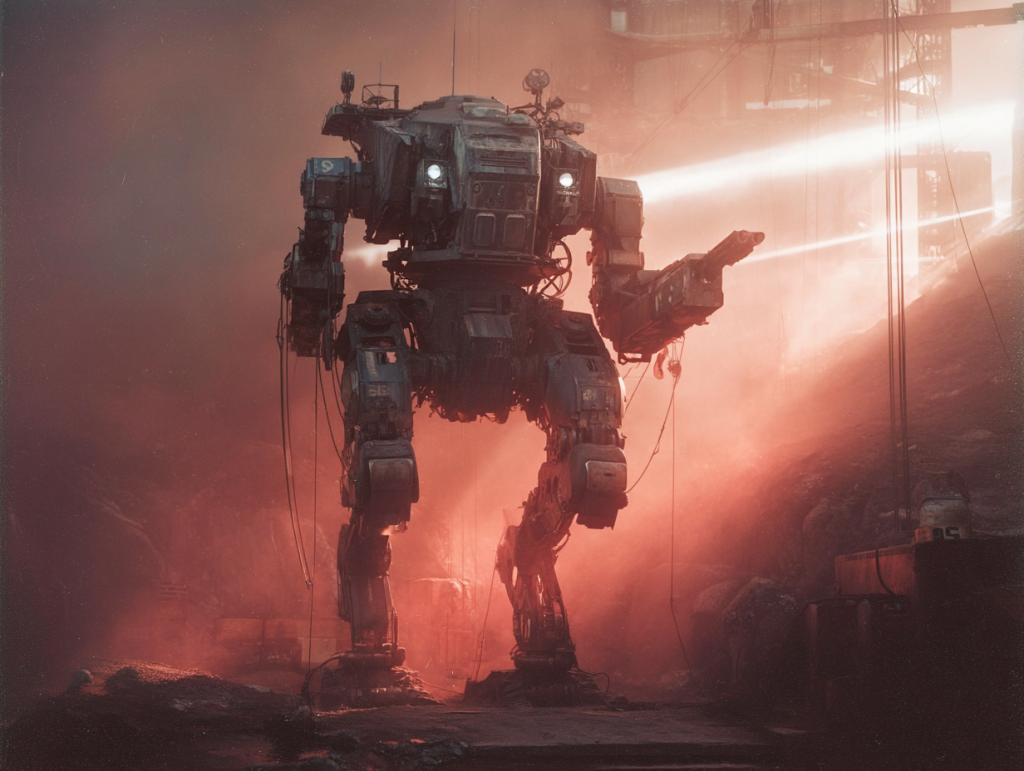
Fast forward to now. This is where Dire Wulf currently stands.
What works about this image:
The posture – That forward-leaning combat stance, aggressive and ready. This is a predator, not a defensive unit. The weight distribution looks right—you can feel the hydraulics maintaining balance, the pilot inside making micro-adjustments.
The lighting – Dramatic backlighting through atmospheric dust, creating that silhouette effect while still showing detail. This is pure Denis Villeneuve influence—the way Blade Runner 2049 uses light to create depth and mood.
The proportions – This is a 7-meter war machine that looks like it could actually exist. Not too bulky, not too sleek. The torso is large enough to house a cockpit. The limbs have visible mechanical joints and hydraulics. It looks like it weighs something.
The atmosphere – Mars dust creating layers of depth, that rust-orange palette, the sense of harsh environment. This machine belongs in this world.
What still needs work:
Weapon details – The long-range rifle and plasma sword aren’t clearly defined yet. I’m still nailing the base model before adding those specific elements.
Neo Helsinki colors – This image doesn’t yet have the black armor with red highlights that defines Neo Helsinki Robot Cores. That’s a refinement I’m adding to my Claude prompt guide now.
The Soul Prism glow – While there’s atmospheric lighting, the cyan bioluminescence from the Soul Prism in the backpack isn’t as visible as it should be. That glow is crucial—it’s the moral weight of the story made visible, the imprisoned alien consciousness powering the machine.
The 360° Challenge
Here’s where I’m headed next: I want to create a complete 360° view of Dire Wulf. Front, side, back views on a white background—clean technical documentation that establishes the definitive design.
This is significantly harder than it sounds. AI image generators create 2D images, not 3D models. Each angle is a separate generation, and maintaining perfect consistency across multiple views requires sophisticated use of reference systems:
- Omni Reference (–oref) to maintain the overall design
- Fixed seed numbers to preserve specific characteristics
- Character reference features to keep proportions consistent
- Careful prompt engineering for each specific angle
I’m working with Claude to develop the exact prompts needed for this technical documentation. Once I have those definitive views, they’ll become the master reference for all future Dire Wulf imagery—combat scenes, hangar shots, dramatic hero moments, everything.
The Emotional Core: That Survival Percentage Joke
There’s a moment in the story that captures Dire Wulf’s personality perfectly. Falck is looking over Crystal City after the Antoniadi incident—a catastrophic event that changed everything. Dire Wulf, the AI merged with his consciousness, stands there in silence. Then it makes a joke about their survival percentage.
It’s such a character beat. Dire Wulf isn’t just a machine Falck pilots—it’s his companion, his partner, his merged consciousness. There’s personality in there, sardonic humor in the face of impossible odds.
How do you capture that in an image?
I’ve been thinking about this. The perfect shot would be from behind Falck’s head, looking at Dire Wulf. Maybe the mech’s posture suggests something—a tilt of the angular head, a particular stance—that reads as sarcastic, as sardonic. The camera angle creates intimacy, the connection between pilot and machine made visible.
This is the next evolution: not just capturing what Dire Wulf looks like, but what it feels like. The personality beneath the titanium.
The Technical Process: How We Generate Dire Wulf Now
Let me show you the current workflow, because it’s sophisticated enough to be interesting:
Step 1: Story Context to Claude
I give Claude a section of story text involving Dire Wulf. For example, the scene where it emerges from a dust storm on approach to the Titan facility.
Step 2: Claude Generates Prompt Variations
Using my comprehensive visual style guide, Claude creates 10 different Midjourney prompt variations:
- Variation 1: Wide environmental shot emphasizing scale
- Variation 2: Low angle making Dire Wulf look imposing
- Variation 3: Action shot mid-stride
- Variation 4: Atmospheric silhouette through dust
- Variations 5-10: Different combinations of angle, lighting, mood
Each prompt includes:
- Specific Pathfinder-class characteristics
- Bipedal humanoid configuration emphasis
- Wolf-inspired angular head design
- Weathering and battle damage details
- Mars environment specifications
- Color palette (desaturated rust-orange)
- Lighting configuration (dramatic backlight through dust)
- Technical camera specs (anamorphic 2.39:1, shallow depth of field)
- Comprehensive negative prompts (no clean surfaces, no animal stance, no CGI gloss)
Step 3: Generation in Midjourney V7
I take those prompts into Midjourney. Often I’ll use Draft Mode first—it’s half the GPU cost and generates 10x faster, perfect for rapid exploration. I generate 20-30 variations quickly to find the best direction.
Once I identify winners, I regenerate them in full quality with the standard rendering pipeline.
Step 4: Reference Building
The best results get upscaled and saved as reference images. These URLs and seed numbers go into my master reference document. Future generations use these references to maintain consistency:
--oref [MASTER_URL] --ow 350-450 --seed [FIXED_NUMBER]This tells Midjourney: “Use this image as the design foundation, weight it between 350-450 for consistency while allowing some variation, and use this specific seed for reproducibility.”
Step 5: Iterative Refinement
Based on what works and what doesn’t, I refine the prompts. Update the style guide. Generate again. The cycle continues.
It’s not magic—it’s systematic iteration guided by clear creative vision.
The TB303 Connection: Sound and Steel
The Roland TB-303 bass synthesizer creates those iconic acid basslines—squelchy, aggressive, rhythmic patterns that drive electronic music forward. There’s something mechanically perfect about its sound, like precisely calibrated machinery generating pure sonic force.
That’s what I wanted Dire Wulf to embody: rhythmic precision, aggressive forward momentum, mechanical perfection in service of a driving purpose. The sound of the TB-303 in my music connects directly to the visual of Dire Wulf advancing through Martian dust.
When you experience Fall of the Titans as the complete transmedia work—reading chapters while listening to the corresponding music tracks—I want that synesthetic connection to click. The bass patterns in the music should feel like Dire Wulf’s footfalls. The aggressive synth leads should feel like its weapon systems engaging.
Sound and steel, rhythm and movement, music and narrative—all synchronized.
What Three Years Taught Me
Lesson 1: Perfection is asymptotic. I’ll probably never generate the “perfect” Dire Wulf image because my vision of perfection keeps evolving as the tools improve and my skills develop. But that’s okay—the pursuit itself creates better and better results.
Lesson 2: Consistency requires systems. You can’t just rely on luck or intuition. You need documented style guides, saved reference images, tracked seed numbers, systematic prompt structures. Creativity within systematic frameworks.
Lesson 3: The breakthrough comes from specificity. The more precisely you can articulate what you want—not just visually but emotionally, atmospherically, thematically—the better your results. “Robots on Mars” gets you chaos. “Industrial brutalist bipedal war machine with MechWarrior aesthetics advancing through atmospheric dust storm with dramatic backlighting” gets you Dire Wulf.
Lesson 4: AI art is a collaboration, not automation. The AI isn’t creating my vision—it’s executing it. I’m the director. I know exactly what I want. The AI is my technical crew, incredibly skilled at rendering but dependent on precise direction.
Lesson 5: Time scales matter. Three years sounds like a long time, but this is how world-building works. You live with your creations, you refine them iteratively, you let them evolve alongside your story. Rushing produces generic results. Patience produces distinctiveness.
The Imperfect Present, The Perfect Future
Am I satisfied with where Dire Wulf is now? Almost. Image 1 is close—so close—to the vision in my head. But there’s still work to do:
- Complete the 360° technical documentation
- Refine the weapon system details
- Perfect the Neo Helsinki color scheme
- Capture multiple story moments (hangar maintenance, combat action, that sarcastic stance looking at Falck)
- Create animation sequences showing movement
But here’s the thing: I’m documenting this journey publicly because we’re living through a unique moment in creative history. In five years, AI image generation will be radically more advanced. Someone will read this blog post and think “wow, it took him THREE YEARS and hundreds of iterations to get that?”
Yes. Because the tools were evolving, I was learning, and the vision was crystallizing. This is how creativity works when you’re working at the edge of new technology—you’re simultaneously artist, engineer, and pioneer.
What’s Next: The Dire Wulf You’ll See
As Fall of the Titans II progresses toward release, Dire Wulf will appear in multiple contexts:
Chapter illustrations – Key story moments visualized, showing Dire Wulf in action alongside Falck and the Wolf Pack
Technical documentation – Clean reference sheets showing the complete design from all angles
Combat sequences – Dynamic action shots that capture the speed and aggression of Pathfinder-class warfare
Character moments – That sardonic stance, the connection between pilot and machine, the personality beneath the metal
Merchandise integration – Through Artlist’s Nano Banan, you’ll be able to wear the same gear that Dire Wulf displays—fiction bleeding into reality
Every image will maintain the aesthetic I’ve spent three years developing: industrial brutalism, atmospheric depth, battle-worn realism, and that distinctive Fall of the Titans visual language that says “this is military science fiction with philosophical weight.”
The Perfect Image Is the Next One
So when will I have the “perfect” Dire Wulf image?
Probably never. And that’s perfect.
Because the pursuit is what matters. Each iteration gets closer. Each refinement reveals new possibilities. Each generation teaches me something about the character, the world, the story I’m telling.
Dire Wulf TB303 started as “robots on Mars” in 2022. Now it’s a fully realized combat platform with personality, history, and presence. By the time Fall of the Titans II releases, it will be even more refined, more consistent, more real.
And somewhere in the future, maybe in Book III or beyond, I’ll generate an image and think: “That’s it. That’s exactly Dire Wulf.” And I’ll realize that the three-year journey—the hundreds of attempts, the systematic refinement, the patient iteration—was what allowed me to recognize perfection when I finally saw it.
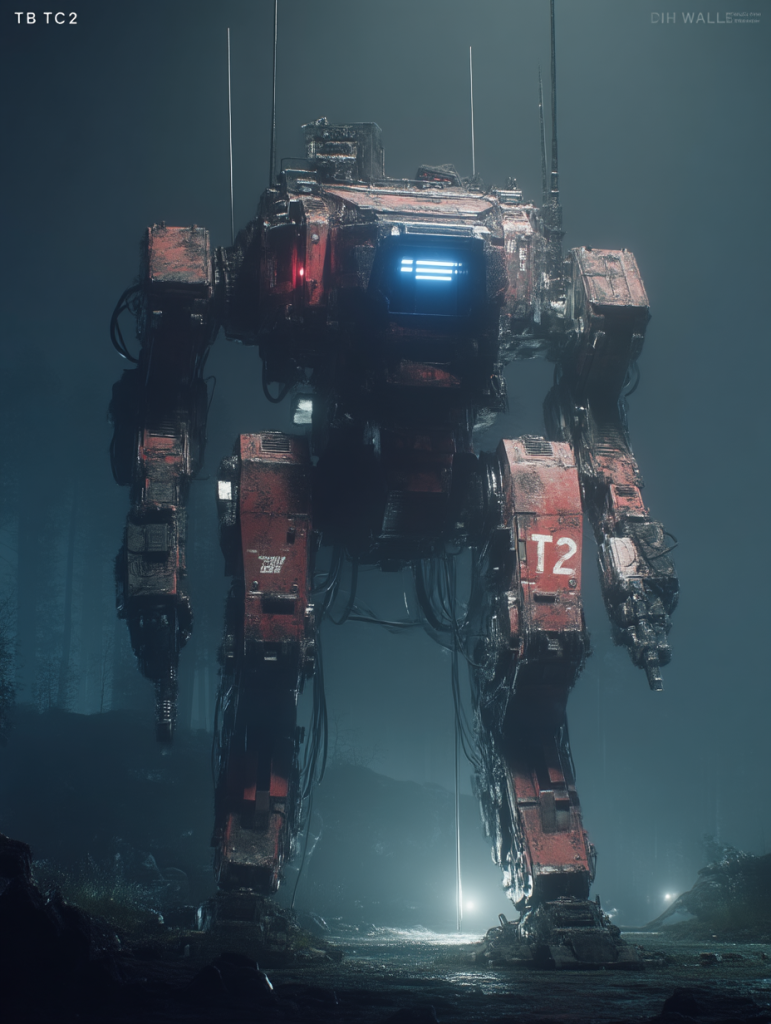
The march to Titan continues. And Dire Wulf walks point.
— Millennium Falck


